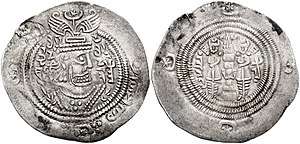Muawiya II
Muawiya II or Muawiya ibn Yazid (Arabic: معاوية بن يزيد, romanized: Mu‘āwiya ibn Yazīd; c. 664–684 CE) succeeded his father Yazid I as the third Umayyad caliph and last caliph of the Sufyanid line. He ruled briefly in 683-684 (64 AH) before he died.[1]
| Muawiya ibn Yazid معاوية بن يزيد | |
|---|---|
| Khalīfah Amir al-Mu'minin | |
| 3rd Caliph of the Umayyad caliphate | |
| Reign | 683–684 CE |
| Predecessor | Yazid I |
| Successor | Marwan I |
| Born | c. 664 CE |
| Died | c. 684 CE (aged 19–20) |
| House | Sufyanid |
| Dynasty | Umayyad |
| Father | Yazid I |
| Religion | Islam |
| Arabic name | |
| Personal (Ism) | Mu‘āwiyah معاوية |
| Patronymic (Nasab) | ibn Yazīd بن يزيد |
| Teknonymic (Kunya) | Abū Laylā |
Early life
Muawiya was the son of Yazid I and an unknown mother from the Kalb tribe. She is often confused with Umm Hashim Fakhita bint Abi Hashim, mother of Muawiya's half-brother Khalid ibn Yazid.[1]
Reign
Before Yazid I died, he had the bay'ah made to his son Muawiya. Muawiya succeeded his father in Damascus in 64 AH (November 683 CE), at an age of somewhere between 17 and 23. He was supported by the Kalb tribe, but his authority was likely only recognised in Damascus and southern Syria, with Abd Allah ibn al-Zubayr claiming the caliphate from his base in the Hejaz.[1]
Muawiya's reign would have lasted for about 20 days to 4 months, but likely no more than 2 months. Given the short span of time, few events were possible, and some of those transmitted may be unreliable political and sectarian fabrications. These include:[1]
- Being a member of the Qadariyya, resulting from the belief that Muawiya abdicated before his death.
- Denouncing his predecessors' tyranny and injustice towards the Alids.[2]
- Having the kunya Abu Layla ("Father of Layla"),[3]:428–429 a name often applied to weak persons. This was suspicious because he had no children.
- Abdication before his death,[3]:468 originating from later Marwanid propaganda.
What does seem certain, is that Muawiya continued his father's policy and remitted a third of the taxes.[4] During his reign, Muawiya suffered from ill health and so had to stay in the Umayyad palace (al-Khaḍrā’) in Damascus. His adviser Al-Dahhak ibn Qays al-Fihri took care of practical affairs.[1]
Death and legacy

It is unclear how Muawiya died, although jaundice and a plague have been named as causes. Since he had no children and either refused[3]:577 or was not given the opportunity to appoint a successor, the campaigns against Ibn al-Zubayr's revolt came to a complete stop. Umayyad power temporarily collapsed until Marwan I took back control.[1]
In his al-Futūḥāt al-Makkiyya, Ibn Arabi claimed that Muawiyya II was a spiritual Pole (Ghawth) of his time and one of the few in history having such a spiritual degree combined with a temporal power, like the Rashidun Caliphs and Umar ibn Abd al-Aziz.[5]
See also
References
- Bosworth, C.E. (1993). "Muʿāwiya II". In Bosworth, C. E.; van Donzel, E.; Heinrichs, W. P. & Pellat, Ch. (eds.). The Encyclopaedia of Islam, New Edition, Volume VII: Mif–Naz. Leiden: E. J. Brill. ISBN 90-04-09419-9.
- Ya'qubi. Tarikh al-Yaqubi. pp. 302–303.
- Al-Tabari. Henri Lammens (ed.). Annales quos scripsit Abu Djafar Mohammed ibn Djarir at-Tabari. II.
- Lammens, Henri (1920). "Moʿâwia II ou le dernier des Sofiânides". Études sur le siècle des Omayyades,. Beirut. pp. 177–179.
- "Parmi les Pôles, il en est dont l'autorité se manifeste et qui détiennent le Califat extérieur, de même qu'en vertu de leur degré spirituel ils détiennent la lieutenance ésotérique. Tel fut le cas de Abû Bakr, de 'Umar, de 'Uthmân, de 'Alî de Al Hasan, de Mu'âwiyah Ibn Yazîd, de 'Umar Ibn 'Abd Il 'Azîz et de Al Mutawakkil " (translation: There are Poles whose authority is manifest and who hold foreign Caliphate, and that according to their spiritual degree they hold esoteric authority to. Such was the case with Abû Bakr, 'Umar, 'Uthmân, 'Alî, Al Hasan, Mu'âwiyah Ibn Yazîd, 'Umar Ibn 'Abd Il 'Azîz and Al Mutawakkil) Le Sceau des Saints, trans. Michel Chodkiewicz, Éditions Gallimard, Paris 1986, p. 121-122.
Muawiya II Umayyad Dynasty Born: c. 664 CE Died: c. 684 | ||
| Preceded by Yazid I |
Caliph of Islam Umayyad Caliph 683 – 684 |
Succeeded by Marwan I |
